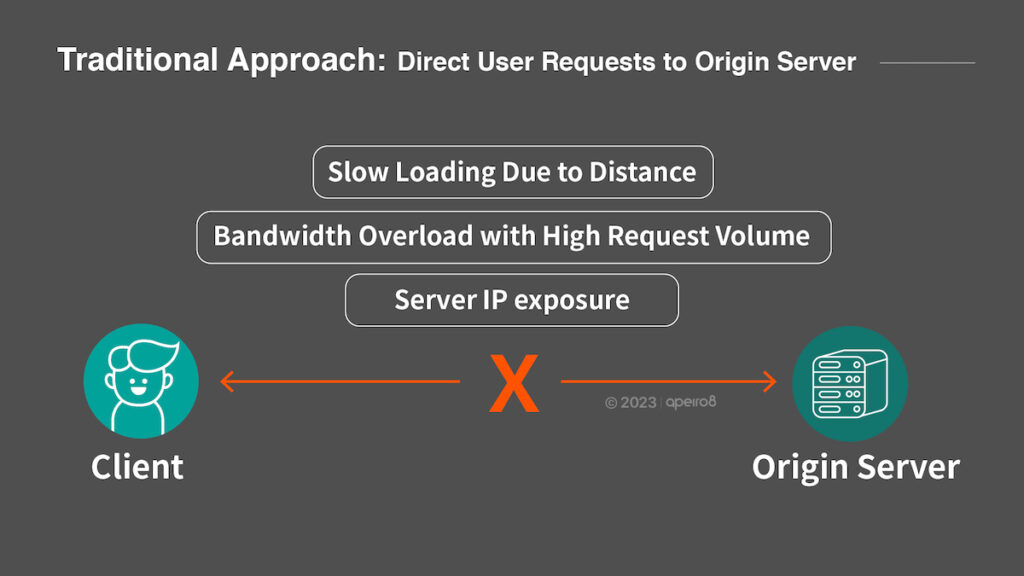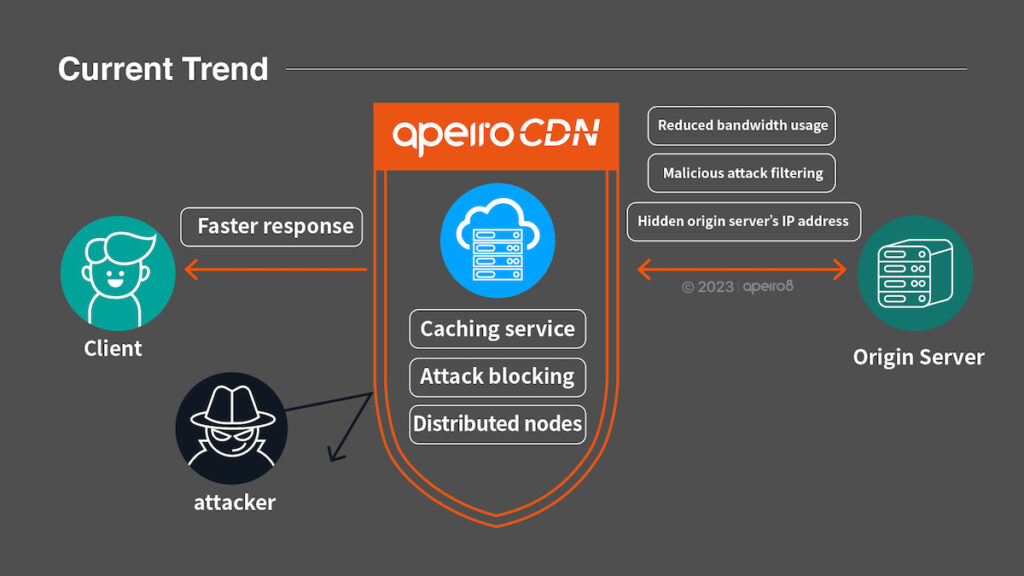What is CDN? Advantages, Trends of Content Delivery Networks
 Back
Back
What is CDN? While most people have heard of CDN, they may still have limited knowledge about this technology. In the following, we will provide a detailed explanation of how CDN (Content Delivery Network) works, its advantages, and current industry trends. Let’s clear up any confusion right away!
What is CDN (Content Delivery Network)?
CDN, short for Content Delivery Network, is a technology that enables efficient content delivery over the internet. It acts as a reverse proxy, utilizing caching and distributed nodes to bring content closer to users, resulting in faster access. Apart from caching, CDN also provides defense mechanisms. Serving as an intermediary between clients and servers, all traffic is filtered through the CDN to protect the origin servers.
The Advantages of CDN (Content Delivery Network)
1. Caching: reduces direct request to the Origin Server, decreases origin server bandwidth usage, and accelerates responses
In general, static content which is usually large-sized can cause issues when continuously requested from the origin server. It may result in the server becoming overloaded or longer response times, leading to service termination when the request volume is high. Moreover, when the origin server is geographically distant from the users, it can lead to slow loading of content and significantly degrade user experience.
Apart from caching static content, CDN can also cache dynamic content. By customizing file types and paths, the CDN administrator can set desired file types and paths for caching. Additionally, forced caching can be employed to cache content that cannot be cached by default, ensuring individual user (website) requirements are met.
2. CDN’s Distributed Nodes Improve Access Speeds Across Geographic Locations
The advantage of a CDN is its ability to cache static content from the origin servers to distributed nodes. Users can access the nearest node to retrieve the same contents as the origin servers, with a loading speed much faster from directly accessing the origin servers. When a website uses CDN service, users from different regions will visit different nodes, while the origin servers can only be accessed by CDN nodes. This can reduce the bandwidth and resource usage on origin servers, improving user experience.
3. Defense Feature: Filtering Abnormal Traffic to Protect Origin Server Operation
In addition to caching, a CDN can prevent the IP address of the origin server from being exposed. As an intermediate between users and origin servers, CDN can provide corresponding protection against malicious attacks. For example, even if the target of the attack is the origin server, using CDN shifts the target to the node, adding an extra layer of protection for the origin server.
Content Delivery: Traditional Approach vs. Current Trends
Traditional Approach: Direct access to origin server by clients
Possible issues:
- Slower response speed due to geographical factor.
- All clients sharing the same bandwidth can easily exceed the limit, causing an abnormal server response.
- The server’s IP address is exposed and prone to malicious attacks.

Current Trend: When clients access the CDN, the CDN will verify whether to retrieve data from the origin server, which reduces loading on the origin server.
- Faster response via caching.
- CDN protects origin servers from malicious attacks.
- Distributed nodes enhance user experience globally.
- Reduced origin server bandwidth usage.
- Hidden origin server’s IP address.

Who Needs a CDN (Content Delivery Network)?
- Websites with a large number of static files and large file sizes, such as advertising industry, auction websites, e-commerce websites.
- Industries with specific caching requirements, such as dynamic content caching for gaming and esports industry.
- Websites with high request volumes, such as major forums, e-commerce websites.
- Websites frequently targeted by malicious attacks, such as gaming industry.
- Websites that require stable service, such as web-based games, e-commerce websites.
⬛ Recommend 1: CDN Tutorial: Reverse Proxy Server Principles & Advantages
⬛ Recommend 2: China CDN Solution: Pros and Cons of CDN services for China
⬛ Recommend 3: How to Tell if a Domain Name Is Blocked by GFW of China
⬛ Recommend 4: Choose a CDN Vendor: The Best Technical Questions to Ask
⬛ Recommend 5: Optimizing CDN Node (PoP) Quantity, Location, and Cost
⬛ Recommend 6: CDN Architecture: Exploring Different Architectures and Benefits
⬛ Recommend 7: CDN Services: Inside the 24/7 DDoS Security Center
⬛ Recommend 8: 5 CDN Bulk Domain Management Strategies for DDoS Defense
⬛ Recommend 9: Apeiro8’s Bespoke CDN Services: Where Speed Meets Security






